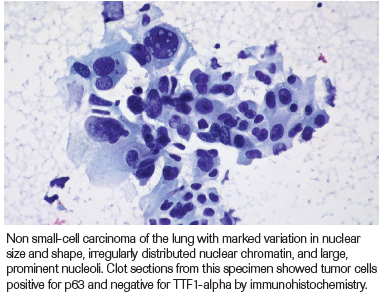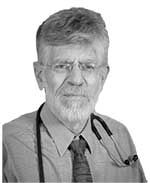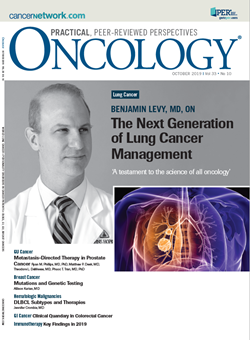Next Generation of Lung Cancer Management
A look at the latest lung cancer research, recent advances in the field and their clinical applications.
Benjamin Levy, MD


ABSTRACT: The most important lung cancer research falls under the hub of personalized medicine. There is an expanding list of lung cancer genotypes that researchers have identified as relevant, and even more importantly, that they have discovered targeted therapies for. In addition, scientists are learning more about predictive markers for immunotherapy that may inform clinicians on how to optimally treat patients. Both targeted therapy and immunotherapy are approved in advanced non-small cell lung cancer and oncologists are learning more about the utility for these drugs in earlier stage disease.
ONCOLOGY recently sat down with Benjamin Levy, MD, of Johns Hopkins University, to learn about his lung cancer research, recent advances in the field and their clinical applications.
Q: What is the most significant science coming out of the lung cancer community right now, and what does it mean for oncologists?
Dr. Levy: The most important research falls under the hub of personalized medicine. There is an expanding list of lung cancer genotypes that we have identified as relevant, and even more importantly, that we have discovered targeted therapies for. In addition, we are learning more about predictive markers for immunotherapy that may inform us on how to optimally treat patients. Both targeted therapy and immunotherapy are approved in advanced non-small cell lung cancer and we are learning more about the utility for these drugs in earlier stage disease.
Q: There is a lot of recent data about targeted therapies. Will you be discussing new results at the upcoming Chemotherapy Foundation Symposium?
Dr. Levy: Yes, We will probably want to make room for the KRAS Amgen 510 drug when we discuss rare lung genotypes, a session that will be tackled by Dr. Drilon. It should be exciting information and data that once again is transforming the way we treat patients
Q: Could you describe some of the most clinically relevant research in your specialty?
Dr. Levy: My interest really is in targeted therapies, but specifically on how we diagnose patients with lung cancer in terms of their genotyping. There is a lot of movement in this space in terms of using liquid biopsies to both genotype lung cancer patients but also as a tool for monitoring in real time how patients are doing on targeted therapies. Looking at longitudinal assessments of the genotype within the plasma to help better understand patient response holds real promise. We are actively discussing how liquid biopsies should be leveraged in everyday clinical practice at our medical crossfire at CFS.
Q: So, liquid biopsies are being used somewhat already, but you are looking at how that can be expanded into everyday practice, including in smaller community oncologist settings?
Dr. Levy: The new data we have with liquid biopsy suggests that every patient with advanced non-small cell lung cancer should potentially have a liquid biopsy in conjunction with their tissue biopsy.[1] We want to educate clinicians, both in academia and in the community on that, and are exploring future applications using data from the longitudinal assessment. This includes studying advanced patients who are on targeted therapy and following their ctDNA over time, as well as looking at results in the minimal residual disease in patients who are cured from their lung cancer from either surgery or radiation, or both. The question we are trying to answer is “Can we detect recurrences in the plasma earlier than we can on a CAT scan and does that translate into better outcomes?”
Q: And that’s where the blood biopsy really comes in?
Dr. Levy: That’s correct.
Q: Obviously chemotherapy is still used widely in most cancer types in one way or another. Do you see us moving away from chemotherapy eventually?
Dr. Levy: Chemotherapy is still utilized in a large majority of our patients, either as first-line or second-line, even for patients with genetic aberrations. But this is the whole movement in oncology, and specifically in thoracic oncology, developing novel drugs that allow us to move away from chemotherapy. Now, that includes targeted therapy, so that’s why it’s so important to identify the target up front, so that we can use the right drug for the right patient. Things like testing for PD-L1 is also important because that also can help drive immunotherapy decisions.
Now that we’ve got targeted therapies and immunotherapies as frontline options, many patients will unfortunately still progress, and we do use chemotherapies in those settings. That as the new big question… how can we get away from using chemotherapy in the refractory space, looking at either novel targeted therapies or immunotherapies, to move away from chemotherapy in advanced non-small cell lung cancer. Eventually. That’s the goal.
Q: So, liquid biopsies are being used somewhat already, but you I guess that’s why you’re seeing the development of drugs for resistance mutations that come in response to a targeted therapy?
Dr. Levy: That’s right. That’s part of it, looking at patients who have a genetic aberration who are treated with a targeted therapy. Trying to understand mechanisms of resistance to that targeted therapy will help inform treatment decisions, and those treatment decisions hopefully will involve another therapy that specifically targets that mechanism of resistance, and then on and on. Beyond that, we hope to do the same thing after the second targeted therapy. This is kind of what we’re learning a bit in ALK-rearranged lung cancer. If patients are on targeted therapy once they progress, mechanisms of resistance may develop[2] that might inform treatment decisions and we can hopefully sequence patients with therapies other than chemotherapy.
Q: What other research has been most notable?
Dr. Levy: The growing list of targeted therapies, the growing list of immunotherapies, but also, of course, CAR-T cells are very important. This is a field of medicine that’s growing rapidly, not so much in the solid tumor space but certainly in the malignant heme space.
Also we are still looking at the role of radiation in many of these solid tumor malignancies. For instance, in lung cancer, we’re learning more and more that radiation can be incorporated for patients who have stage IV disease . But for patients who have what we call “oligometastatic disease,” there may be a real role for radiation therapy. The themes of precision medicine and biomarker implementation are most important.
I want to add that, while it’s important to talk about the science, it’s also important to talk about how we approach the patients comprehensively. And that includes all facets of care – the emotional needs, the evaluation of a patient’s fitness, specifically looking at elderly patients, even looking at comorbidity, the importance of assessing heart-related issues for cancer patients, for example. Treating the whole patient is critical.
Key Question
At this time, is it standard for most patients to have testing for the four big genetic aberrations? Are there four others that the majority should be testing for as well, and do most oncologists have the ability to follow that protocol? Is it common place across non-small cell lung cancer treatment?
Dr. Levy: Every patient should have comprehensive genomic profiling, a next-generation sequencing for their tumor that includes those four genes and beyond. We need to get a better understanding of the genomic underpinnings. Most testing that’s done these days should include a larger panel, at least a 50-gene panel, if not more. The days of just doing four are over. Every patient should get next-generation sequencing, or what I call “comprehensive genomic profiling.” That can be achieved in two ways. One is a tissue biopsy, the other is through liquid or plasma.
Disclosure:Dr. Levy has consulted for Merck, Celgene, Takeda, Pfizer, Genentech, Eli Lilly, Guardant, and Astra Zeneca.
PERSPECTIVE

Amidst Treatment Breakthroughs, Also Strive to Prevent
Alan Blum, MD
As physicians, we need to directly engage with every one of our patients who smoke. A nonthreatening strategy to help a patient stop is to shift the focus from the person to the product. For example, the filter is consumer fraud. We need to debunk the myth that filtered cigarettes (which are purchased by 99% of patients who smoke) are in any way safer. In fact, those who buy filtered brands have to inhale more deeply to get the smoke through the filter, thus breathing in higher concentrations of carbon monoxide, cyanide, and other poisonous gases and increasing the risk of emphysema and heart disease. Similarly, “low tar” just means a few less cancer-causers and other poisons (“Would you buy a loaf of bread that was advertised as having only 1 ounce of aflatoxins or a can of tuna that has only 1 milligram of mercury?”); “lights” and “ultra-lights” just mean more sugar or other sweeteners; and menthol is just an anesthetic that deadens the throat to make the smoke seem less harsh.
Another topic to address with high school and college students is e-cigarettes, especially JUUL, which have become alarmingly popular. JUUL was designed to produce a more rapid absorption of nicotine and thus to result in earlier addiction. However, humor is a more effective approach than finger-wagging and scare tactics. For instance, matter-of-factly mentioning the inevitable yellow teeth and zoo breath of a teenager who smokes Marlboro or the goofy-looking image of a JUUL user sucking on a flash drive has a better chance of sinking in than talking about lung cancer or heart disease.
Overall, the keys to lung cancer prevention are the commitment of every physician and every medical school dean and every hospital administrator to make smoking prevention and smoking cessation (and relapse prevention) a top priority; environmental reinforcement through clean indoor air legislation and paid satirical mass media campaigns; and social reinforcement by family, friends, co-workers, employers, and one and all.
Financial Disclosure:The author has no significant financial interest in or other relationship with the manufacturer of any product or provider of any service mentioned in this article.
Dr. Blum is a family physician, Professor, Gerald Leon Wallace, MD, Endowed Chair in Family Medicine, and Founding Director of the UA Center for the Study of Tobacco and Society, University of Alabama School of Medicine, Tuscaloosa, Alabama.

Newsletter
Stay up to date on recent advances in the multidisciplinary approach to cancer.